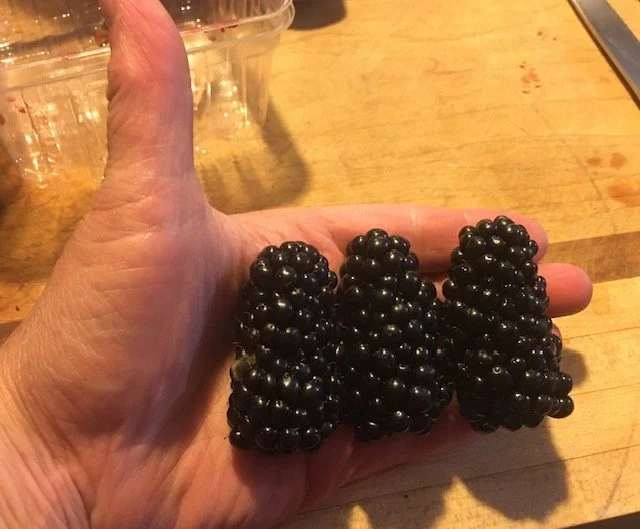BIG Berries
One of the advantages of being a vendor at the farmers market is I have first crack at everything before the hordes of locust, err, I mean customers rush through the isles to acquired the limited varieties of local goodies that cannot be gotten in any grocery store, no matter how haute they bill their business. But for those patrons who are as seasoned as a good cast iron skillet, they know that being first in line is the key to snapping up these precious gems. And the serious foodies know their loot by name.
There are over 500 different varieties of blackberry cultivars for growers to choose from, but customers aren’t concerned with resistance to orange rust, cane blight, double blossom, anthracnose, and phytophthora root rot. They don’t care if the canes are erect or trailing, thornless or with thorns. No, they’re after bold, sweet blackberry flavor, druplets bursting with deep purple juice.
When I was a kid it was always the men who did the black berry picking in their chest waders and brush pants normally worn during hunting season. Grandma would make a sponge cake laden with the fresh berries and we’d eat it warm with a big splash of milk soaked into the dessert.
When I first moved back to Pennsylvania to farm I wanted blackberries to be one of the foods I grew as a crop. But being young and inexperienced I couldn’t wait a year to watch the weather, instead planting a 200-foot row of Arapaho canes on a high-tensile trellis only to have the first year canes whipped to death by brutal winds before they could ever produce fruit. So the trellis became part of a the fenceline for livestock and I replanted more blackberries elsewhere on the farm. Unfortunately, those two agricultural endeavors don’t exist well together. Goat will escape and they will seek out and eat every single blackberry bush they can find. I came to accept that if I wanted fresh blackberries someone else would have to grow them.
So last week as we were setting up our market tents the berry people only had to say one work for me to drop everything and go directly to their tables—Chickasaws. Had I known about this variety back in my early days I would have planted them and then erected Fort Knox around them to guarantee the goats (and deer and anyone else) would not get near the plants or ripe fruit. But back in the day I would have ignored this variety because it had thorns. I guess that’s what they mean when they say age plus experience offers wisdom.
Not to be a pig about things, I only purchased two boxes of the monster berries, waiting for the peak season to arrive to procure my winter stash for the freezer. Had I not hidden away my loot in a cooler I would have eaten both boxes over the course of the market. Yes, they’re that good!
Although berries of such size may look like fruit thugs, in all their luscious ripeness they are the delicate and easily bruised, not lending well to long-distance transportation. These chonks aren’t something you blithely chuck into a market bag along with the rest of the week’s groceries. Each week I watch as patrons protectively balance cardboard boxes back to their cars or stash spots before continuing on with their shopping.
Once started, berry season runs through the summer. With farmers ranging from Virginia to Pennsylvania, the availability is stretched longer by the multiple varieties that mature at different intervals. Some vendors grow as many as ten different cultivars for a maximum season.
While blackberries may be the stars of dessert, they are equally delicious in savory dishes and salads. Don’t forget happy hour either. A frozen Chickasaw makes the perfect ice cube.
Speaking of freezing, blackberries are extremely easy to freeze—just wash, drain, and pop into an airtight container. They won’t stick together in a solid clump making them perfect for popping a few in your yogurt or dropping into pancake batter or muffins during the winter months. One customers told me she has a house rule that frozen berries can’t be touched until the winter months. I’m with her on that one.

